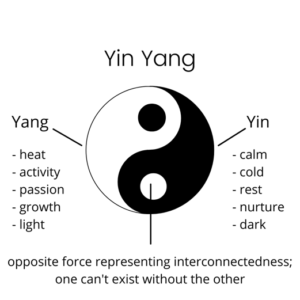
You may have noticed it on everything from jewelry to candles to health food products and you can even see it in the window of the CNMA office.
It’s the black and white circle (although colors can vary) with a swirl in the middle and 2 dots in either side: the symbol for yin and yang.
So what does it mean?

Yin (the black or dark part of the symbol) represents the female side of the universe and constitutes:
- calm
- rest
- passivity
- nurturing
- contemplation
and is associated with darkness, cold, nighttime, winter, and the moon.
Yang (the white or light part of the symbol) represents the male side of the universe and stands for:
- heat
- strength
- expansion/growth
- passion/excitement
- activity
and is related to daytime, light, fire, summer, and sun.
The symbol represents the dualism between the two forces and how they are interconnected throughout the universe (as seen in the natural world as well as the man-made one).
The small dot in either main force means that neither can exist without the other.
Naturally, this concept applies to the earth and its cycles (think fire versus water, summer versus winter, and activity versus hibernation) but it also extends to the human world.
Take for instance personality characteristics – do you have more of yin personality or a yang one?
Yin personalities are more:
- relaxed
- quiet
- slow
- imaginative
- introverted
Yang personalities are more:
- energetic
- fast-paced
- logical
- courageous
- extroverted
Each of these personalities are strengths in their own rights – but too much of one without the other can make way for difficulties.
For example, a yin-only personality may suffer from:
- lack of motivation
- sluggishness or sleepiness
- always running late
- overanalyzing
And a yang-only personality can deal with:
- the inability to relax
- sleep issues
- frustration and upset
- unmet expectations
This is why working to develop an opposite force trait from the dominant personality can help bring about balance.
How does this relate to health?
Yin and yang are what qi (energy) is comprised of. When qi is unbalanced (from too much yin or too much yang), unwanted symptoms, illness, and disease can arise.
Just like with personality traits, living too much in one type of energy can create unbalance throughout the entire body.
Unbalanced energy shifts can commonly happen from:
- eating a poor diet
- lack of exercise
- inadequate sleep
- unmanaged stress
- not enough relaxation
- absence of purpose
Many of which are simply effects of everyday life in American culture.
So how do you know if your yin or yang are unbalanced?
Not being able to fall or stay asleep, an upset stomach, moodiness, pain, chronic disease, or acute symptoms are all cues the body can give off when there is a lack of equilibrium.
The good news is that there are a variety of helpful ways to decrease excess energy force and create more moderation.
Stay tuned for our next article, 10 Tips to Bringing Balance Back Into Focus for tangible ideas.
If you feel your energy is unstable, Dr. Graves is here to help.
For those in Castle Rock, Castle Pines, Highlands Ranch, Lone Tree, Centennial, Parker, Larkspur, Monument, Colorado Springs, and the greater Denver metro area, please call us at (303) 688-6698 or click here to schedule a free 15 minute phone consultation with Dr. Graves to discuss how your excess or depleted energy may be stuck in one force or the other.

Leave a Reply